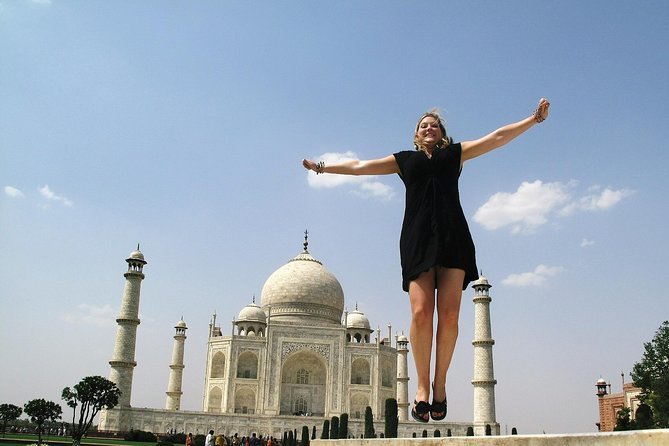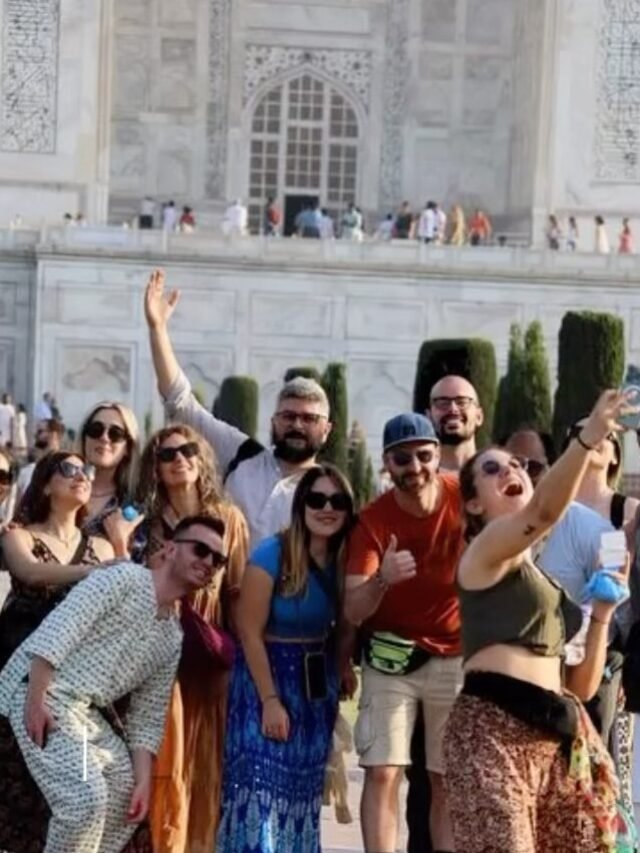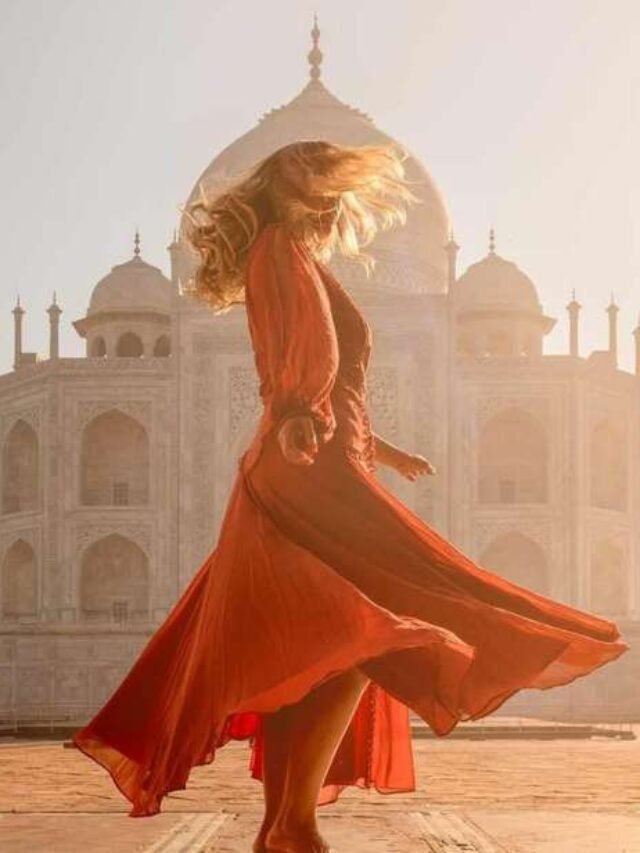The Taj Mahal stands as a timeless testament to love and architectural grandeur, situated in Agra, India. Commissioned by Mughal emperor Shah Jahan in memory of his beloved wife Mumtaz Mahal, it is hailed as one of the most magnificent examples of Mughal architecture in the world. Constructed between 1632 and 1653, this UNESCO World Heritage Site showcases exquisite craftsmanship with its intricate marble carvings, symmetrical gardens, and ornate domes. Its iconic ivory-white facade reflects different hues under the sunlight, evoking a sense of ethereal beauty and serenity.
Also you like to read One-Day Tour of Agra: Top Attractions to Visit in 12 Hours
Visiting the Taj Mahal promises an awe-inspiring experience steeped in history and romance. As you approach the grand entrance gate, adorned with intricate calligraphy and delicate marble inlays, anticipation builds for the breathtaking sight that awaits within. Visitors can explore the main mausoleum, the picturesque gardens, and the surrounding structures, soaking in the architectural marvels and the poignant love story behind its creation. With its timeless allure, the Taj Mahal continues to captivate hearts and minds from around the globe, inviting travelers to embark on a journey of wonder and reverence amidst its majestic splendor.
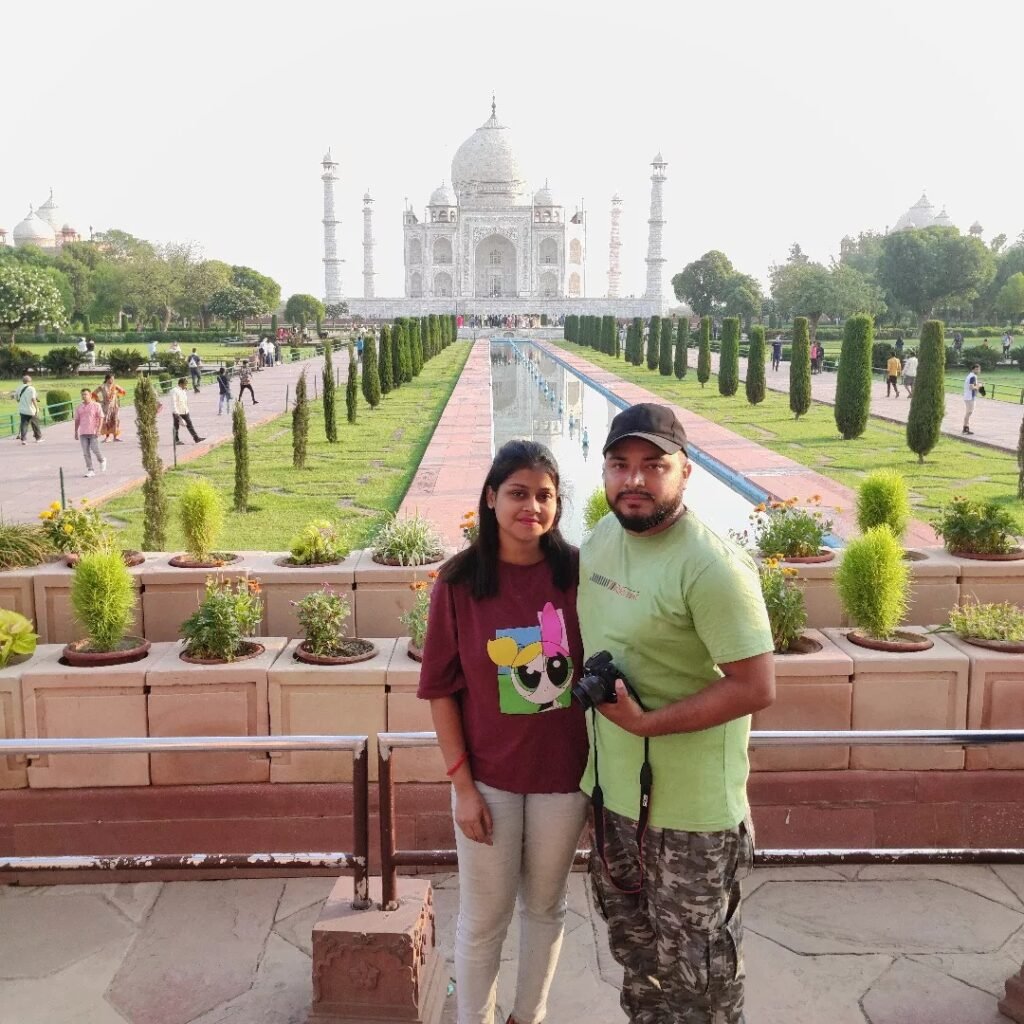
Delhi Agra one day tour by Car – Book with Local Expert From ₹ 6,500
Delhi Agra one day tour by Car Inclusive of neat and clean Car with Experienced Driver + Local Live Guide on Additional cost – Check Out More!
View DetailsHistorical significance of the Taj Mahal
The Taj Mahal holds profound historical significance as an enduring symbol of love, artistry, and the Mughal Empire’s grandeur. Commissioned by Emperor Shah Jahan in memory of his beloved wife Mumtaz Mahal, it embodies the pinnacle of Mughal architecture, showcasing exquisite craftsmanship and meticulous detailing. Beyond its architectural magnificence, the Taj Mahal represents a testament to the enduring power of love and the cultural legacy of India.
Its construction not only reflects the opulence and sophistication of the Mughal era but also serves as a poignant reminder of the profound emotions that can inspire monumental achievements in human history. Today, it stands as a UNESCO World Heritage Site, captivating visitors from around the world with its timeless beauty and rich historical narrative.
Best time to visit the Taj Mahal
The best time to visit the Taj Mahal is during the cooler months of October to March, when the weather in Agra is more pleasant and comfortable for exploring the monument and its surroundings. The winter months offer mild temperatures and clear skies, ideal for appreciating the intricate details of the Taj Mahal’s architecture and strolling through its picturesque gardens without the discomfort of extreme heat.
Additionally, visiting early in the morning or later in the afternoon allows for softer lighting conditions, enhancing the beauty of the marble structure and providing stunning photo opportunities. However, regardless of the season, it’s advisable to check for any significant holidays or events that may attract larger crowds and plan accordingly to ensure a more serene and enjoyable experience at this iconic monument.
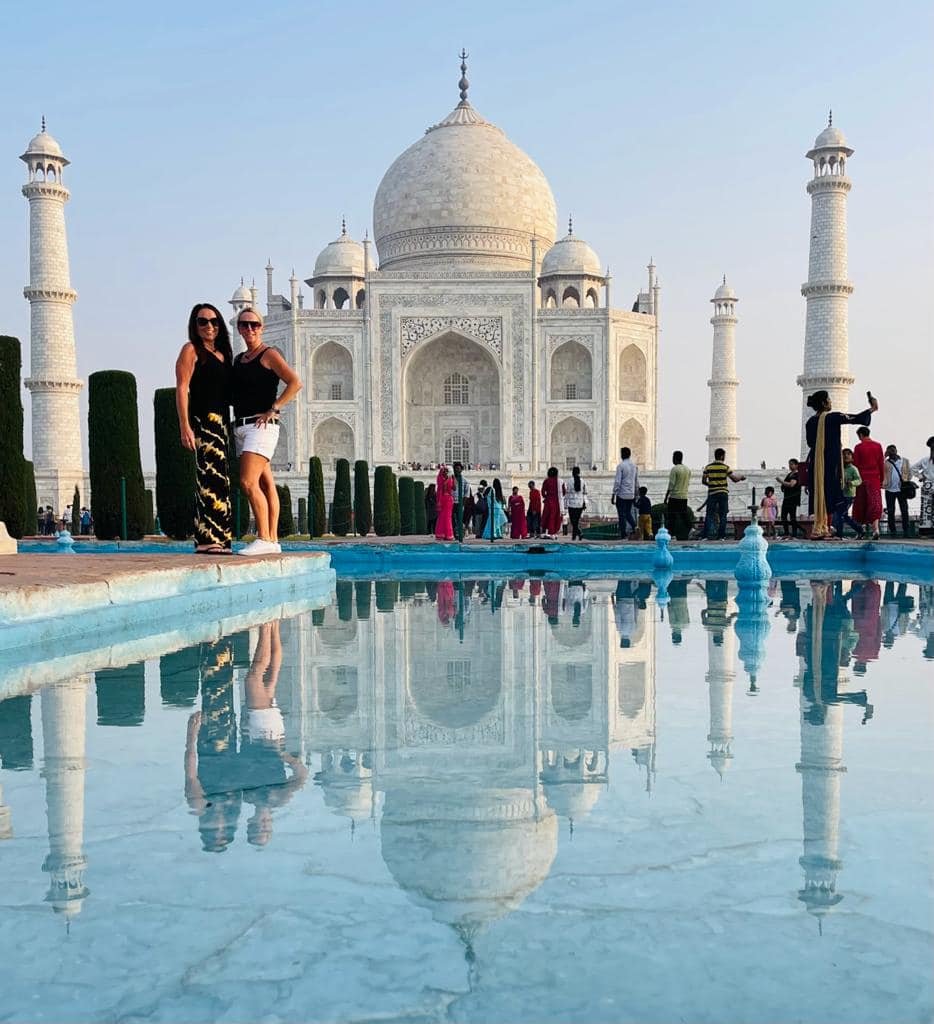
How to reach the Taj Mahal
Reaching the Taj Mahal is relatively straightforward due to its popularity and central location in Agra, India. For those arriving by air, the nearest major airport is the Agra Airport, which offers domestic flights from several Indian cities. Alternatively, travelers can fly into the Indira Gandhi International Airport in New Delhi and then take a train or hire a taxi to Agra, which is approximately a three to four-hour journey by road or train. Agra is well-connected by train to major cities across India, with the Agra Cantt railway station being the main railway hub in the city.
Additionally, numerous buses and private taxis ply the route between Agra and other nearby cities, making it accessible for visitors from various parts of the country. Once in Agra, reaching the Taj Mahal is convenient, as it is located just a few kilometers from the city center, and can be easily reached by auto-rickshaw, taxi, or even by walking for those staying in nearby accommodations.
Taj Mahal entry ticket prices
The entry ticket prices for the Taj Mahal vary depending on nationality. For Indian citizens, the ticket price is lower compared to foreign tourists. Additionally, there are separate rates for visitors from SAARC (South Asian Association for Regional Cooperation) countries. Children below the age of 15 can enter for free, regardless of nationality.
There are also different ticket options available, including tickets for entry to the main mausoleum and surrounding gardens, as well as combined tickets for entry to other nearby attractions. It’s advisable to check the official website or inquire locally for the most up-to-date information on ticket prices and any applicable discounts.
Must-see attractions near the Taj Mahal
While visiting the Taj Mahal, there are several must-see attractions nearby that further enrich the cultural experience. One such attraction is Agra Fort, a UNESCO World Heritage Site located just a few kilometers away. Built primarily as a military structure by Emperor Akbar, Agra Fort later served as the main residence of the Mughal emperors.
Its impressive architecture, intricate carvings, and fascinating history make it a captivating destination for history enthusiasts. Exploring the fort offers insights into the grandeur and power of the Mughal Empire, with highlights including the Jahangir Palace, the Diwan-i-Khas (Hall of Private Audience), and the Sheesh Mahal (Palace of Mirrors).
Another notable attraction near the Taj Mahal is the Mehtab Bagh, also known as the Moonlight Garden, situated across the Yamuna River from the monument. This lush garden complex provides a serene setting to admire the Taj Mahal from a different perspective, especially during sunset or sunrise when the monument is bathed in soft, golden light.
Mehtab Bagh offers panoramic views of the Taj Mahal’s reflection in the river and is an ideal spot for photography enthusiasts seeking stunning vistas of this iconic monument. Additionally, the garden’s tranquil ambiance provides a peaceful retreat from the bustling crowds, allowing visitors to savor the beauty of the Taj Mahal in a more contemplative setting.
Taj Mahal monument facts
The Taj Mahal, a UNESCO World Heritage Site located in Agra, India, is renowned for its stunning architecture and rich history. Constructed between 1632 and 1653 by Mughal Emperor Shah Jahan in memory of his beloved wife Mumtaz Mahal, it is an exquisite example of Mughal art and craftsmanship. The monument is crafted from white marble, adorned with intricate inlay work featuring precious and semi-precious stones, and is surrounded by lush gardens and reflecting pools.
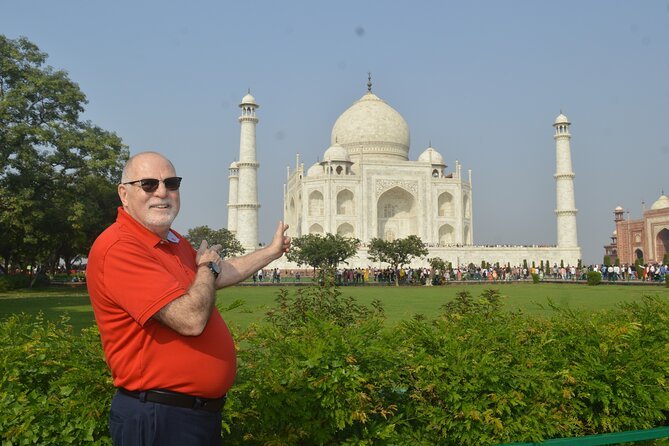
The central dome of the Taj Mahal reaches a height of 73 meters (240 feet), while its four minarets stand at 40 meters (131 feet) tall. Interestingly, the Taj Mahal appears to change color throughout the day, reflecting different hues of pinkish-white under the sunlight, adding to its ethereal beauty. Beyond its architectural marvels, the Taj Mahal remains a symbol of enduring love and is visited by millions of tourists each year, making it one of the most iconic landmarks in the world.
Taj Mahal architecture details
The Taj Mahal’s architecture blends elements of Persian, Islamic, and Indian styles, showcasing intricate geometric patterns and delicate marble carvings. Its symmetrical design and perfect proportions reflect the Mughal emphasis on balance and harmony. The central dome, flanked by four smaller domes, creates a striking silhouette against the sky. The use of white marble, coupled with inlaid gemstones and calligraphy, lends the monument an unparalleled sense of elegance and grandeur.
- Taj Mahal location and directions – The Taj Mahal is located in Agra, Uttar Pradesh, India. It is situated on the southern bank of the Yamuna River, near the city center, and can be easily reached by various modes of transportation from major cities such as Delhi and Jaipur.
- Taj Mahal opening hours – The Taj Mahal is open to visitors from sunrise to sunset, every day of the week except Fridays, when it is closed for prayers. Visitors can explore the monument and its surrounding gardens during these hours, with tickets available for purchase at the entrance gates.
- Taj Mahal ticket prices – The ticket prices for visiting the Taj Mahal vary depending on nationality. For Indian citizens, the entry fee is typically lower than for foreign tourists. Additionally, there are separate rates for visitors from SAARC (South Asian Association for Regional Cooperation) countries.
- Taj Mahal guided tours – Guided tours of the Taj Mahal are available for visitors who wish to enhance their experience with expert insights into the monument’s history, architecture, and significance. These Taj Mahal Guided tours are led by knowledgeable guides who provide in-depth commentary and facilitate a deeper understanding of the Taj Mahal’s cultural and historical importance.
- Taj Mahal sunset view timings – The Taj Mahal offers a breathtaking sunset view, best experienced during the last hour before closing time. During this period, visitors can witness the monument bathed in the warm hues of the setting sun, creating a magical ambiance that adds to the timeless beauty of this iconic landmark.
- Taj Mahal nearby attractions – Nearby attractions to the Taj Mahal include the Agra Fort, a UNESCO World Heritage Site known for its impressive architecture and historical significance, and Mehtab Bagh, a serene garden offering stunning views of the Taj Mahal across the Yamuna River, especially during sunset. These sites complement the Taj Mahal experience, providing visitors with additional insights into the rich history and cultural heritage of Agra.
- Taj Mahal visitor reviews – Visitor reviews of the Taj Mahal often praise its mesmerizing beauty, intricate architecture, and serene ambiance, describing it as a truly unforgettable experience. Many visitors are captivated by the monument’s romantic allure and express awe at its stunning marble craftsmanship, making it a must-visit destination for travelers from around the world.
- Taj Mahal photography tips – When photographing the Taj Mahal, consider visiting during sunrise or sunset for softer lighting and vibrant colors. Additionally, explore various angles and perspectives to capture the monument’s grandeur and intricate details, while also being mindful of crowds and using a tripod for stability in low-light conditions.

Why the Taj Mahal is a Monument of Love and Legacy
The Taj Mahal stands as a monumental symbol of love and legacy due to its poignant origin story and timeless architectural beauty. Commissioned by Mughal Emperor Shah Jahan in memory of his beloved wife Mumtaz Mahal, the Taj Mahal represents an enduring tribute to their profound love and devotion. Beyond its romantic significance, the Taj Mahal embodies the cultural and artistic legacy of the Mughal Empire, showcasing exquisite craftsmanship, intricate marble carvings, and symmetrical design.
Also you like to read Uncovering the Legacy of Hur-ul-Nisa: The Beloved First Daughter of Mughal Emperor Shah Jahan
Its status as a UNESCO World Heritage Site further solidifies its importance as a globally recognized monument, captivating millions of visitors with its timeless allure and serving as a testament to the enduring power of love and human creativity across generations.
Here are 10 questions people often ask about the Taj Mahal when planning a Delhi Agra Tour, along with interesting facts about the monument:
The Taj Mahal was commissioned by Mughal Emperor Shah Jahan in 1632 to honor the memory of his beloved wife, Mumtaz Mahal, who died during childbirth. It took approximately 22 years and thousands of artisans to complete this architectural masterpiece, which combines Persian, Islamic, and Indian architectural styles. The Taj Mahal stands as a symbol of enduring love and is considered one of the most iconic landmarks in the world.
The construction of the Taj Mahal began in 1632 and was completed in 1653. It took approximately 22 years to build this magnificent monument, with thousands of skilled artisans and laborers contributing to its creation under the supervision of Mughal Emperor Shah Jahan. The Taj Mahal stands as a testament to timeless love and exquisite architectural craftsmanship.
The Taj Mahal holds significant cultural and historical importance as a symbol of love, architectural excellence, and the Mughal Empire’s grandeur. It serves as a poignant tribute to the enduring love between Emperor Shah Jahan and his wife Mumtaz Mahal. Additionally, the Taj Mahal is recognized globally for its breathtaking beauty and exquisite craftsmanship, attracting millions of visitors each year to marvel at its splendor.
To visit the Taj Mahal, you can travel to Agra, Uttar Pradesh, India, either by air, train, or road. Once in Agra, you can easily reach the monument by hiring a taxi, auto-rickshaw, or walking from the city center to the Taj Mahal complex entrance gates.
Yes, there are entry fees for visiting the Taj Mahal, which vary depending on nationality. Indian citizens typically have lower entry fees compared to foreign tourists, with separate rates for visitors from SAARC countries. Children below the age of 15 can enter for free.
The best times to visit the Taj Mahal are during the cooler months of October to March, when the weather is more pleasant for exploring the monument and its surroundings. Additionally, visiting early in the morning or later in the afternoon allows for softer lighting conditions and fewer crowds, enhancing the experience of witnessing the Taj Mahal’s beauty.
Yes, visitors are allowed to take photographs inside the Taj Mahal complex, including the main mausoleum and surrounding gardens. However, drone photography is prohibited, and there may be restrictions on the use of tripods or selfie sticks in certain areas.
While there isn’t a strict dress code enforced at the Taj Mahal, it’s advisable to dress modestly and respectfully, covering shoulders and knees. Avoiding revealing clothing and wearing comfortable footwear is recommended for exploring the monument and its surroundings.
Yes, there are several restrictions for visiting the Taj Mahal, including prohibitions on bringing large bags, food, and tobacco products into the complex. Additionally, visitors are not allowed to bring drones or tripods for photography, and certain areas may be off-limits for photography or exploration.
The Taj Mahal changes color depending on the time of day, appearing pinkish-white in the morning, milky white in the evening, and golden under the moonlight. It is believed that the calligraphy on the Taj Mahal’s entrance gate gets larger as it ascends, giving the illusion of uniform size when viewed from a distance.
#Discover the history, architecture, and visitor information about the iconic Taj Mahal monument. Plan your trip with our detailed guide!
TajMahal #Agra #India #UNESCO #Architecture #Love #History #TravelTips #VisitIndia #CulturalHeritage #Photography #SunsetView #EntryFees #DressCode #VisitorRestrictions #FactsAboutTajMahal
https://alamgirtajmahalguide.com/taj-mahal-monument-information/













